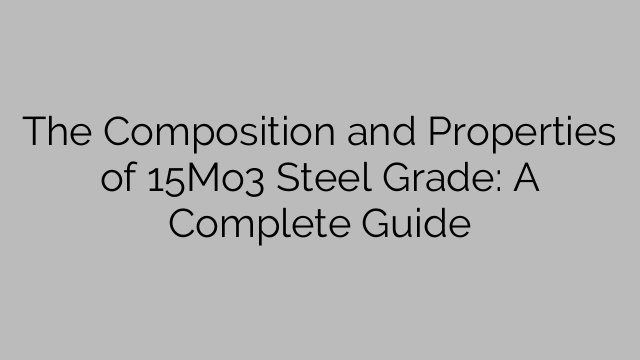The Composition and Properties of 15Mo3 Steel Grade: A Complete Guide
1. Introduction
15Mo3 steel is a low-alloy steel commonly used in the production of boilers, pressure vessels, and pipes in the oil and gas industry. It is characterized by its high temperature resistance and good weldability.
2. Chemical Composition
The chemical composition of 15Mo3 steel is as follows:
– Carbon (C): 0.12-0.20%
– Silicon (Si): 0.10-0.35%
– Manganese (Mn): 0.40-0.90%
– Phosphorus (P): 0.025% max
– Sulfur (S): 0.010% max
– Chromium (Cr): 0.30% max
– Molybdenum (Mo): 0.25-0.35%
3. Mechanical Properties
The mechanical properties of 15Mo3 steel are as follows:
– Tensile Strength: 450-600 MPa
– Yield Strength: 275 MPa min
– Elongation: 22% min
– Impact Toughness: 0°C min
– Hardness: 125-165 HB
4. Technical Properties
– Density: 7.85 g/cm³
– Melting Point: 1420-1460°C
– Thermal Expansion: 10.1-10.6 x10⁻⁶/°C
– Thermal Conductivity: 26-35 W/mK
– Specific Heat Capacity: 460-480 J/kg°C
– Electrical Resistivity: 0.20-0.24 µΩ·m
5. Applications
15Mo3 steel is primarily used in the production of boilers, pressure vessels, and pipes for high-temperature services. It is also used in power plants, oil refineries, and chemical plants where high-temperature and high-pressure conditions are present.
6. Weldability
15Mo3 steel has good weldability and can be easily welded using conventional welding methods. However, preheating and post-weld heat treatment may be required to reduce the risk of cracking and improve the weld’s mechanical properties.
7. Machinability
15Mo3 steel has good machining properties. It can be easily machined using conventional methods such as drilling, milling, and turning. However, as it is a low-alloy steel, cutting tools should be properly selected to ensure good surface finish and tool life.
In conclusion, 15Mo3 steel is a low-alloy steel with high-temperature resistance and good weldability. It is commonly used in the production of boilers, pressure vessels, and pipes in the oil and gas industry. Understanding its composition and properties is essential for ensuring its proper application and performance.

